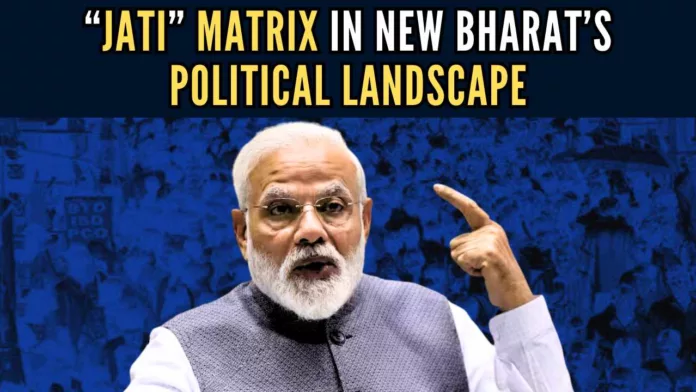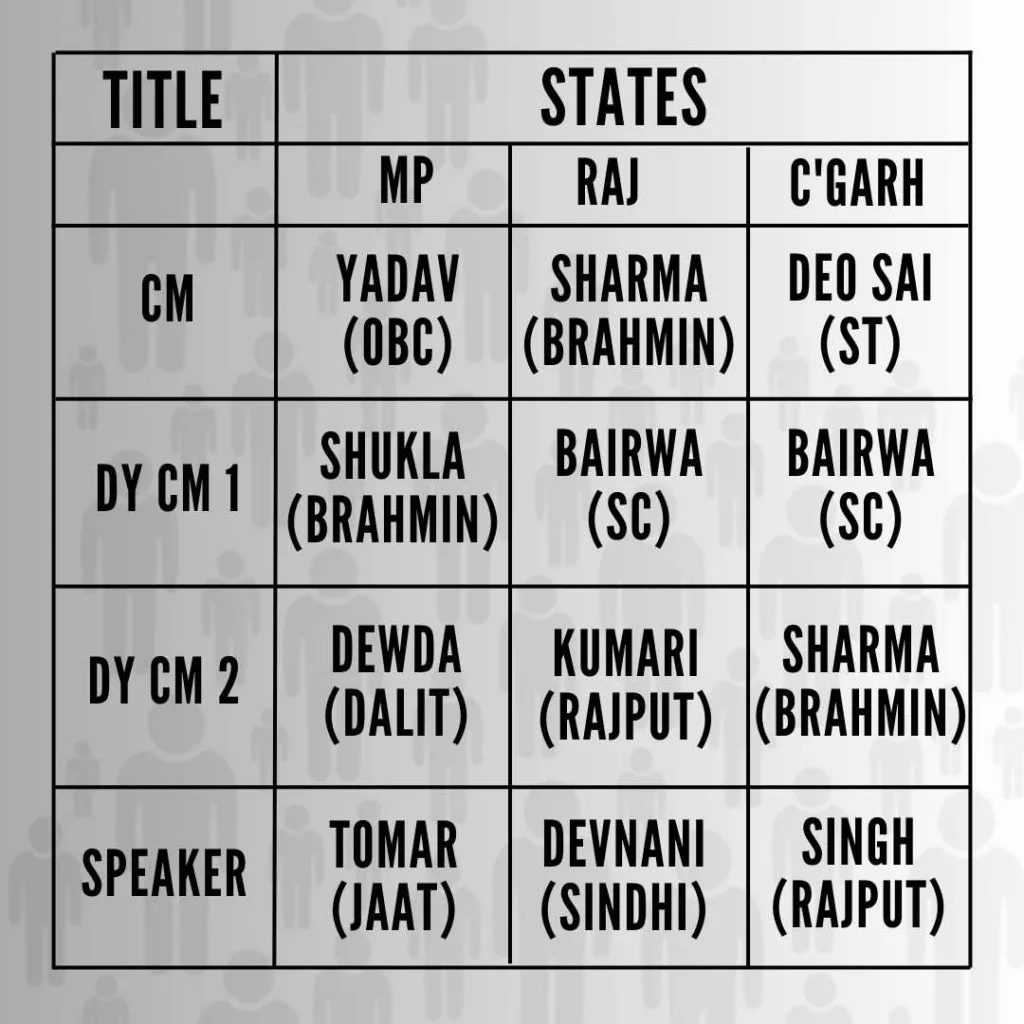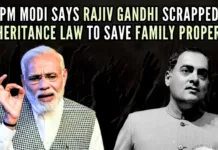
Big surprises with two edges
The unprecedented BJP victory in the three States (Madhya Pradesh, Rajasthan, and Chhattisgarh) reaffirms Modi’s leadership for the third term in the 2024 national elections. More importantly, the Modi team struck two-edged big surprises in the new Bharat’s political landscape.
The first is the choice of the relatively unknown faces as the Chief Ministers, a closely held secret until the day of announcements. Modi surprised all political pundits, analysts, and media strategists. There were dozens of names and faces on the television, social media, and print media for days but almost none of them finally emerged on the list. Modi’s team successfully guarded the names, unlike the frequent leaks of the exam papers during the former Rajasthan government led by Congress.
The second penetrating stroke is Modi’s meticulously crafted “Jati” matrix which has never been seen before. Call it what you may, the Jati matrix by Mature Modi, Mysterious Modi, Mindful Modi, and/or Meticulous Modi. It is only Modi who can make magical things happen; “Modi hai to Mumkin hai” and the Modi Magic.
Jati versus Caste
We deliberately refrain from using “caste” for Jati because the two are by no means synonyms. The British Raj imposed a caste system to divide and rule India with its origin in the Portuguese word ‘Casta’.
The Brown Raj in independent India politicized the caste to new heights for the vote bank and further divided us.
Today, we have the General category (including Brahmin, Vaish, and Rajput), and Dalit plus the OBC (Other Backward Class), SC (Scheduled Caste), and ST (Scheduled Tribe). As if it was not enough, the Modi government in 2019 added an “Economically Backward” class within the General category for 10% reservation in education and government jobs.
Jati matrix
Returning to the Jati matrix, shown in the table below, it is a meticulous balancing of SC, ST, OBC, Dalit, and General categories. Who could imagine and make it happen? Only the Modi team with innovative minds – a mix of career bureaucrats, politicians, and a work-alcoholic Modi himself. The team worked behind the scenes and concocted a good mix of Chief Ministers – a Tribal leader in Chhattisgarh, an OBC in Madhya Pradesh, and an Upper Caste (Brahmin) in Rajasthan.
These Chief Ministers are complimented by two Deputy Chief Ministers in each State with an equally good blend of various Jati categories shown below.

Another innovation of mindful Modi is that while the top three leaders reflect an almost perfect Jati blend and balance with relatively new and inexperienced political figures, the Speakers are chosen from among the more experienced. For example, Tomar in Madhya Pradesh is the former Cabinet Minister, Raman Singh in Chhattisgarh is its former Chief Minister, and Devnani in Rajasthan has a proven record of electoral victories dating back to 2003.
Other credentials
I did not check everyone’s record but almost certainly, they all moved up the ladder in BJP with their grounding in Rashtriya Swayamsevak Sangh. Consequently, they are believed to be very disciplined and principled Hindu nationalists with strong values and ethics.
Generally, educational credentials and age are no criteria for political leadership in Bharat. But it is changing in the Modi period. The majority in the table above are relatively young with a maximum age of around 60 years. The collective educational credentials speak volumes about the chosen team with only a handful without a college degree. Their mix of backgrounds ranges from Political Science to Fine Arts, Physics to Law, and Business to Engineering (Electrical and Civil). Their university degrees include Bachelor, Masters, and even Doctorate. The most academically credentialed is Madhya Pradesh’s CM Yadav with two Master’s, LLB, and Ph.D.
While the matrix above is a good mix of Bharat’s Jati categories, it falls short on gender balance. Only the Rajasthan team has a woman (Divya Kumari from the Royal family). I wonder if it is a slap on the face to silence another Royal family member, the former CM Vasundhara Raje. Another huge surprise is the induction of the first Tribal leader as Chhattisgarh CM similar to the nomination and election of the first ever Tribal woman President of Bharat. With the new Bill passed earlier this year, more legislative seats will be reserved for women. This will build capacity for women leaders with significant potential for a better gender balance in the future.
Modi’s strategies
Undoubtedly, Modi thinks long-term. The Jati Matrix is a carefully crafted social engineering. It is also a cleverly mixed blend of politics and Jati to counter the Congress-led I.N.D.I.A.’s demand for a pan-India caste census. Modi has played his Jati card so well that the caste census idea has fallen flat. It is also worth noting that Modi did not play in his own OBC background previously but now he is becoming more vocal about it.
A Yadav CM in Madhya Pradesh should help woo the voters in Uttar Pradesh and Bihar. It may even be a threat to the family dynasties of Mulayam Singh and Lalloo Prasad, respectively. The choice of Brahmin and Rajput in leadership positions is equally critical to winning all Parliamentary seats in Madhya Pradesh, Rajasthan, and the neighboring areas. The Tribal leaders, the President of Bharat, and the CM in Chhattisgarh will foster BJP trust and attract Tribal votes everywhere.
The long-term strategy of the Jati matrix with magical, mindful, mysterious, and meticulous Modi and his team is multi-faceted. Can anyone dare doubt the Modi team’s victory trumpet in 2024 with the latest Modi Guarantees? If you still have any doubts, add his vision of the Sankalp Yatra delivering a nationwide message of Viksit Bharat aimed at raising awareness about government schemes.
Ab ki baar, phir Modi sarkar with his mantra of Sab ka Saath, Vikas, Prayas, and Vishwas.
Jai New and Viksit Bharat.
Note:
1. Text in Blue points to additional data on the topic.
2. The views expressed here are those of the author and do not necessarily represent or reflect the views of PGurus.
For all the latest updates, download PGurus App.
- Education and election in Bharat: Race to the top - April 16, 2024
- Kejriwal: “An Insignificant Man” or a corrupt politician with impending prison term - March 24, 2024
- Bharat’s general elections and the Model Code of Conduct - March 22, 2024











It’s indeed remarkable to witness the efforts made by Modiji and the BJP in balancing the intricate Jati matrix. However, it’s disheartening to observe that many Indians lean towards identifying themselves not solely as Indian or Hindu, but by their Jaati. The fact that caste or Jaati considerations continue to influence voting decisions rather than focusing solely on development highlights an enduring challenge.
The necessity for the BJP to navigate and balance these considerations indicates that many people prioritize their last name over the broader national or political agenda. This trend emphasizes the deep-seated influence of social classifications in the country’s political landscape, often superseding the core issues and developmental aspirations.
PGurus,
“work-alcoholic”? No line editors today?